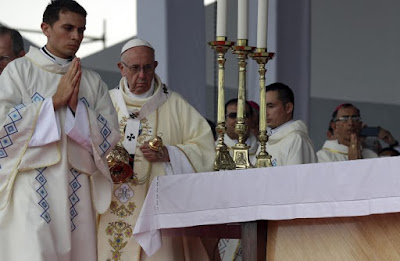Double of the II Class (1954 Calendar): September 21
Before St. Matthew became an Apostle, he was a publican or, more colloquially, a tax collector. St. Matthew may have worked for the Roman Empire or for Herod Antipas. The Roman Empire collected taxes indirectly by farming out the collection process to members of the rich Equestrian class. These Equestrians bought the right to collect taxes at public auctions. The taxes were then deposited in the Roman Treasury while the Equestrians hired local men to collect the taxes from the district’s inhabitants. Anything over the agreed amount of taxes was income to the Equestrians with the local tax collector also collecting his percentage of the earnings. Corrupting elements were built into every transaction.
Without strong safeguards, the collection of custom duties may become arbitrary and tyrannical. The tax collector is able to force merchants or travelers to unpack every wagonload and loosen every package. To add the injury of national pride to monetary loss, the local tax collectors were Jewish helping the hated invader, Rome. Even if St. Matthew worked for Herod Antipas, he would still have been ostracized:
“Even in Galilee, where one like Matthew may have been serving Herod Antipas and may have been collecting lawful customs from the caravans which moved along the great commercial highway, he would be regarded with suspicion and classed with social and religious outcasts.” (Erdman. 1920. pg. 7)Publicans were in the same class as heretics and offenders against the Church. Of course, this is not to say that St. Matthew himself was dishonest or tyrannical as he went about his tax-collecting. It is, however, a measure of his ambition or his need for money that he was willing to take a job that was despised by the rest of the inhabitants of Galilee. The Gospels tell us that St. Matthew did well too – well enough to host a banquet for many of his friends when he decided to follow Jesus. It is even more remarkable then that he walked away from his lucrative if unsavory occupation and towards Jesus when Christ called him.
For more on the lives of all the Apostles, pick up a copy of "The Twelve: Lives and Legends of the Apostles" on paperback or as part of the online course on the Apostles, which includes a Certificate of Completion.
Collect:
O Lord,may the prayers of the blessed apostle and evangelist Matthew help us to obtain the graces we ourselves cannot acquire by our merits. Through our Lord . . .
Collect:
O Lord,may the prayers of the blessed apostle and evangelist Matthew help us to obtain the graces we ourselves cannot acquire by our merits. Through our Lord . . .















